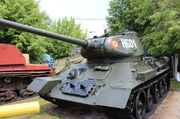The T-34 is a Soviet medium tank introduced in 1940, famously deployed during World War II against Operation Barbarossa.
Its 76.2 mm (3 in) tank gun was more powerful than its contemporaries while its 60 degree sloped armour provided good protection against anti-tank weapons. The Christie suspension was inherited from the design of American J. Walter Christie's M1928 tank, versions of which were sold turret-less to the Red Army and documented as "farm tractors", after being rejected by the U.S. Army. The T-34 had a profound effect on the conflict on the Eastern Front in the Second World War, and had a lasting impact on tank design. After the Germans encountered the tank in 1941, German general Paul Ludwig Ewald von Kleist called it "the finest tank in the world" and Heinz Guderian affirmed the T-34's "vast superiority" over German tanks. "As early as July 1941, OKW chief Alfred Jodl noted in his war diary the surprise at this new and thus unknown wunder-armament being unleashed against the German assault divisions." Although its armour and armament were surpassed later in the war, it has been described as the most influential tank design of the war.
The T-34 was the mainstay of Soviet armoured forces throughout the war. Its general specifications remained nearly unchanged until early 1944, when it received a firepower upgrade with the introduction of the greatly improved T-34/85 variant. Its production method was continuously refined and rationalized to meet the needs of the Eastern Front, making the T-34 quicker and cheaper to produce. The Soviets ultimately built over 80,000 T-34s of all variants, allowing steadily greater numbers to be fielded despite the loss of tens of thousands in combat against the German Wehrmacht. Replacing many light and medium tanks in Red Army service, it was the most-produced tank of the war, as well as the second most-produced tank of all time (after its successor, the T-54/T-55 series). With 44,900 lost during the war, it also suffered the most tank losses ever. Its development led directly to the T-44, then the T-54 and T-55 series of tanks, which in turn evolved into the later T-62, T-72, and T-90 that form the armoured core of many modern armies. T-34 variants were widely exported after World War II, and as recently as 2018 more than 130 were still in service.
Type
Medium tank
Place of origin
Soviet Union
Service history
In service
1940–1960s (Soviet Union)
1950s–present (by other states)
Used by
Soviet Union and 39 others
Wars
World War II, and many others
Production history
Designer
KhMDB
Designed
1937–1940
Produced
1940–45 (USSR),
1951–55 (Poland),
1951–58 (Czechoslovakia)
No. built
84,070
35,120 T-34
48,950 T-34-85
Specifications (T-34 Model 1941)
Mass
26.5 tonnes (29.2 short tons; 26.1 long tons)
Length
6.68 m (21 ft 11 in)
Width
3.00 m (9 ft 10 in)
Height
2.45 m (8 ft 0 in)
Crew
4 (T-34)
5 (T-34-85)
Armour
Hull front 47 mm /60° (upper part)
45 mm (1.8")/60° (lower part),
Hull side 40 mm/41°(upper part),
Hull rear 45 mm,
Hull top 20 mm,
Hull bottom 15 mm;
Turret front 60 mm (2.4"),
Turret side 52 mm/30°,
Turret rear 30 mm,
Turret top 16 mm[verification needed]
Main
armament
76.2 mm (3.00 in) F-34 tank gun
(T-34-85: 85 mm ZiS-S-53 or D-5T gun)
Secondary
armament
2 × 7.62 mm (0.3 in) DT machine guns
Engine
Model V-2-34 38.8 L V12 Diesel engine
500 hp (370 kW)
Power/weight
18.9 hp (14 kW) / tonne (T-34) 15.6 hp (11.6 KW) / tonne (T-34-85)

The T34 Heavy Tank.
Suspension
Christie
Ground clearance
0.4 m (16 in)
Operational
range
250–330 km (T-34) (250 mi)
250–300 km (T-34-85) (150 mi)
Maximum speed
53 km/h (33 mph)
